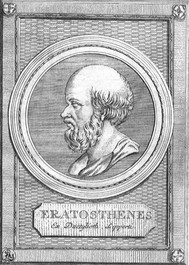The Intersection of Euclid & Eratosthenes
In order to understand how the intersection of Euclid and Eratosthenes led to the first estimate of the Earth's circumference (with remarkable accuracy!), we looked in detail at Euclid's Proposition 29 which states that: Together, we broke down the statement to identify each part and students restated the definition using the names of lines and angles from an example diagram to make sure the statement made sense to them before we moved forward. Line a falling on line b and line c makes:
 Using our understanding of Euclid's Proposition 29, we were then able to see how Eratosthenes applied this principle (and excellent critical thinking skills) to obtain his famous estimate of Earth's circumference. Eratosthenes knew that in Syene, which is located in southern Egypt, the Sun at noon on the summer solstice shines down to the bottom of a well. He also knew that at noon on this, the longest day of the year, objects do not cast shadows. However, in Alexandria, which is farther north, at noon on the summer solstice, he noticed that objects do cast shadows. Eratosthenes used this simple observation to calculate the circumference of the Earth. He assumed that 1) the Sun's rays strike the Earth in parallel lines, and 2) that the Earth is round (recall, not everyone at this time and for many years to come believed in a round Earth!). The approach he used was to measure the distance between Syene and Alexandria based on the number of steps someone took to walk between the two cities. He then measured the shadow cast by a stick placed vertically in the ground at Alexandria at noon on the summer solstice. He measured the angle from the stick to the shadow and found it be 7.5 degrees, or approximately one-fiftieth of a circle. Since Eratosthenes was familiar with Euclid's work and The Elements, he knew that the angle of the shadow cast by the pole is equal to the angle at the Earth's center between Syene and Alexandria. By multiplying the distance from Syene to Alexandria times 50, Eratosthenes was able to calculate the circumference of the Earth with amazing accuracy! At that time, distance was measured in stadia. The distance between the two cities was approximated to be 5,000 stadia which is equivalent to about 800 km, or 500 miles. Eratosthenes estimated the circumference of Earth to be 25,000 miles - that's within 2% of our current best estimates! Final Projects and Homework During the last 15 minutes of class students worked independently on a review/test which covers concepts from Chapters 14-18 in the textbook. We will go over the answers together in class next week.
I met with each student individually to discuss their ideas for a final science fair project. It looks like we will have a great variety of topics covered and I'm looking forward to seeing where the students take their ideas and what they will create for final presentations! For homework this week, I would like students to prepare a one-paragraph description of their project and the approach they plan to take - you will need to hand these in to me on Monday. This will help ensure that everyone has clearly thought out and can articulate their project. Please take time this week to think through what you will research, build, and present (visually and orally) to the class. We have only a few short weeks left in the semester and everyone should have a definite project idea and be moving forward. Any questions or concerns, I am here to help you, so please don't hesitate to contact me. Additionally, students should read Chapters 20 and 21 in the text. See you next week! Comments are closed.
|
Categories
All
Archives
May 2016
|




 RSS Feed
RSS Feed